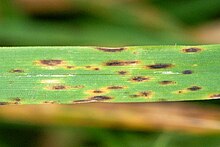Cochliobolus sativus
| Cochliobolus sativus | |
|---|---|

| |
| Symptoms on a wheat leaf | |
| Scientific classification | |
| Domain: | Eukaryota |
| Kingdom: | Fungi |
| Division: | Ascomycota |
| Class: | Dothideomycetes |
| Order: | Pleosporales |
| Family: | Pleosporaceae |
| Genus: | Cochliobolus |
| Species: | C. sativus
|
| Binomial name | |
| Cochliobolus sativus (S. Ito & Kurib.) Drechsler ex Dastur (1942)
| |
| Synonyms | |
|
Bipolaris californica (Mackie & G.E. Paxton) Gornostaĭ (1978) | |
The fungus Cochliobolus sativus is the teleomorph (sexual stage) of Bipolaris sorokiniana (anamorph) which is the causal agent of a wide variety of cereal diseases. The pathogen can infect and cause disease on roots (where it is known as common root rot), leaf and stem, and head tissue. C. sativus is extremely rare in nature and thus it is the asexual or anamorphic stage which causes infections. The two most common diseases caused by B. sorokiniana are spot blotch and common root rot, mainly on wheat and barley crops.
Identification
The mycelium of B. sorokiniana is usually deep olive-brown. New cultures produce abundant simple
The sexual state (C. sativus), when formed in culture, is in the form of black, globose
Host species
Bromus inermis1, B. marginatus1, B. willdenowii1
Festuca sp. 1
Guzmania sp. 1
Saccharum sp. 1,
Notes
Geographical distribution
Cochliobolus sativus has a world-wide distribution.
| Geographical distribution | |
|---|---|
| Africa | Kenya,1 Malawi,1 Sudan,1 South Africa, 1 Tanzania, 1 Zimbabwe1 |
| Australasia | Australia,1 China, 1 Korea, 1 India, 1 Indonesia, 1 New Zealand,1 Papua New Guinea,1 Taiwan, 1 Thailand1 |
| Central America | Cuba, 1 Mexico, 1 Nicaragua1 |
| Europe | Austria, 1 Belgium, 1 Czechoslovakia, 1 Denmark, 1 Finland, 2 Germany, 1 Greece, 1 Hungary, 1 Italy, 1 Poland, 1 Scotland, 1 United Kingdom, 1 USSR |
| North America | Canada (Alberta, 1 Manitoba, 1 Saskatchewan1) US (Indiana, 1 Kansas, 1 Minnesota, 1 Montana, 1 New York, 1 North Dakota, 1 South Dakota, 1 Utah, 1 Virginia1) |
| South America | Argentina, 1 Brazil1 |
Notes
1. USDA ARS Fungal Database 2. [1]
Main diseases
Common root rot (barley); Common root rot (wheat); spot blotch (barley); Spot blotch (wheat)
Spot blotch of wheat
This is most important disease in non-tradition wheat growing areas. The B. sorokiniana comes with Pyrenophora tritici-repentis and causes millions of tons of wheat loss each year. The symptoms are blotch as well as induced senescence due to premature chlorophyll losses Rosyara et al., 2007[dead link].
